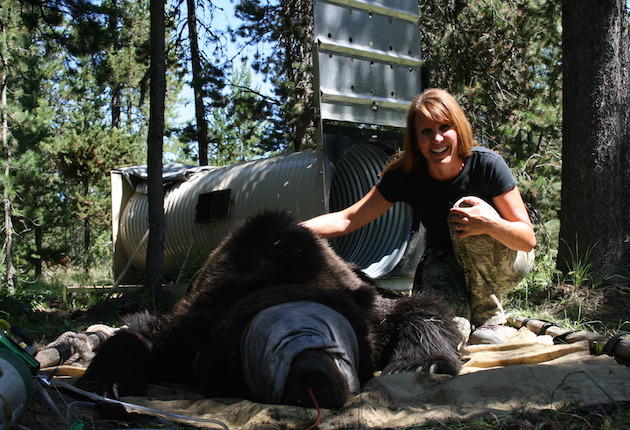My mom says I don’t have a danger gene. In this instance, I’m thinking she’s wrong. My hand hovers over a pelt. A slight tremor reaches my fingertips. I’m hesitating.
That’s not like me, but any common sense soul would pause when put in my position. I’m in the far back of the backcountry with a grizzly bear; our run-in is no accident.
“There’s really a small number of people worldwide who work with these species,” says Bryan Aber, Idaho Department of Fish and Game wildlife biologist. “It’s a pretty cool thing to be part of that and help recover the population in the Yellowstone Ecosystem.”
Aber is a beast of a man in his own right. It took me years of solid storytelling to prove myself worthy of this bear-trapping trip. I’m thrilled to work with him, even when he rolls his eyes at me as I lay down on the tarp beside him. His hands are in the bear’s mouth and my hands are all over my camera.
“Really Millgate?” he whispers. I whisper back, “You do your job, I’ll do mine.”
The rapport between us is stern, but well developed over our common interest. Aber knows bears like no other and, as a journalist, it’s my job to know the know-it-alls.
“The grizzly bear population has recovered from somewhere less than 200 bears in the early 1980s to more than 700,” Aber says. “It’s a recovered population now and should be delisted and that’s a good feeling to be part of that.”
I’m witnessing one day in two decades of grizzly bear research in the West. The drugged animal sleeping on an outdoor operating table made of a tarp covered in tools is grizzly bear No. 227. He’s the first grizzly captured for research in modern-day Idaho. That was back in 1994 when the population fell to an endangered level. No. 227 likes rotten elk meat. He’s been baited into a trap 12 times in 20 years.
I watch the screws tighten on No. 227’s new GPS collar. Hair samples are pulled. Blood is drawn. There’s a wound festering from a recent bear fight, but an old scar from a hunter’s gunshot in 2009 is still trouble free. No. 227’s teeth are wearing down. His weight is down too. He’s aging.
This is all documented in less than 45 minutes.
The sleepy time tranquilizer wears off from nose to toes and the bear is starting to give his tongue a mouth massage. Time is running out and my shaky hand is still hovering. The research crew quietly jokes about my hesitation. I quickly bite back, reminding them we are all kneeling around something that could kill me with one paw swipe.
Finally, I dismiss the danger like my mom says I always do and I go for a grab of grizzly fur. It’s deep, dense and dirty. Just like little boys on summer vacation, baths are optional for big bears too.
I run my hand along the huge hump between the bear’s shoulders. His breathing is extremely slow and deep. The calm, restful state of such a powerful brute makes me giddy.
Fear fades in the omnivore’s coarse coat, but my hand is still shaking when I stand up. Touching a grizzly, even a sleeping one, will do that to you.
Visit tightlinemedia.com for more from Kris Millgate!

